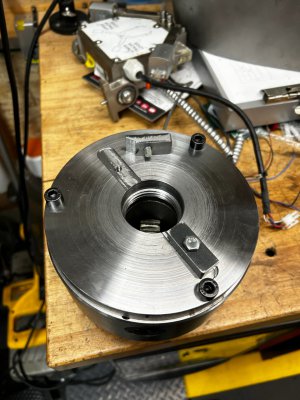- Joined
- Jun 26, 2018
- Messages
- 1,733
I was thinking of Winky’s workshop & him moving his chuck on the spindle back to reduce flex. As this was just a prototype/proof of concept, I used some steel I had on hand, it wasn’t ideal as it was almost .250” shy on diameter, but worked out fine but just not to my preference.
As I have a screw on chuck, I had to consider the lock downs, which are really the problem in the first case. This is what pushes the chuck forward about .650” more than I’d like just so you can access the locks.
This is what did to squeeze their size down.

Here is where the stock cast iron backplate sat (1.5” from headstock) which has about .002” of flex.
Stock back plate
Here is the steel back plate moved .650” closer to head stock
New back plate
And for what it’s worth, the chuck plate made on this lathe has about .0005” runout.
Runout
New position
Original position
Now , I’m sure there is something I overlooked or did I correctly, let me have it before I make version II, not to mention I plan on remaking all my back plates. I have chased after small gains of rigidity on the compound, no reason to to chase that dragon on the chuck! No?
As I have a screw on chuck, I had to consider the lock downs, which are really the problem in the first case. This is what pushes the chuck forward about .650” more than I’d like just so you can access the locks.
This is what did to squeeze their size down.

Here is where the stock cast iron backplate sat (1.5” from headstock) which has about .002” of flex.
Stock back plate
Here is the steel back plate moved .650” closer to head stock
New back plate
And for what it’s worth, the chuck plate made on this lathe has about .0005” runout.
Runout
New position
Original position
Now , I’m sure there is something I overlooked or did I correctly, let me have it before I make version II, not to mention I plan on remaking all my back plates. I have chased after small gains of rigidity on the compound, no reason to to chase that dragon on the chuck! No?
Last edited:

